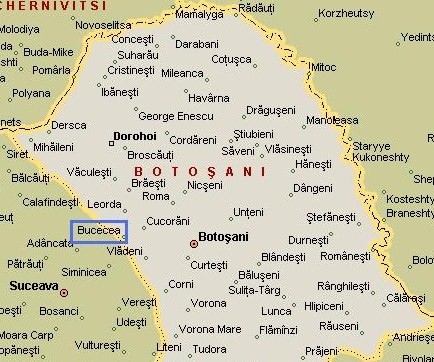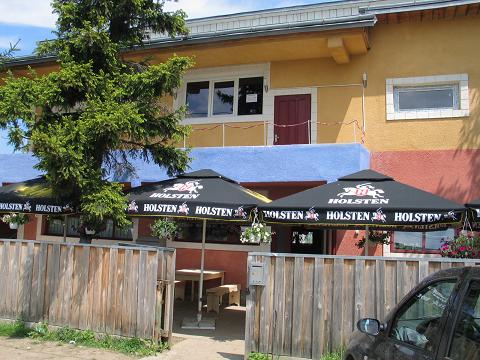BUCECEA 1828 January 16
With God kindness,
I, IOAN SANDU STURZA., Voevod and Prince of the Moldavian Country,
Considering the
written application of
our honest and faithful Boyard Alexandru Ralet, sword bearer, that in
his estate, Bucecea, from Botosani region : there is room enough to
create a market town, neighbouring villages and many houses, in My
Reign, I consider that this application is not only right, but will
resuscitate the private businesses, not creating any harm for the
proposed land. We approve this application and we give him complete
freedom to do this market town, investing his money and to bring
foreigners, out of this country and not from other small towns and
villages, who will be exempt to pay any taxes for the land.
This
measure is to
create stability for
the newcomers in this town, however I legislate the followings :
- First- Nobody can
open a store, shop,
without to buy from the owner the land, the parcel necessary for the
business, measured in length and across, no matter if the parcel is
in the town or suburb.area
- Second- Nobody can
sell beer,
alcoholic beverages or kerosene without the approval of the estate's
owner.
- Third- .The
butcheries, bread
bakeries, candle stores and soap stores will be the property of the
Boyard, unless of those, who by mutual understanding with the Boyard,
will be permited to have such properties.
- Forth- The leaders
of the guilds,
selected by the townsmen will be under the control of the owner of
the estate.
- Fifth- Those who
will not have stores
and will like to open temporary stands or to have moving carts with
merchandise, or to sell only during fairs, should have the approval
of the owner of the estate.
- Sixth- The pasture
for the townmen's
cattles, living in the suburb, will be located and divided by the
owner of the estate as folows : 1/2 of a hectare, counting this
surface for two oxes and a cow without calfs. For the townsmen living
on the streets, the same size of land for a horse and a cow without
calfs. Those who want a larger area should pay to the Boyard, how
much will be the mutual agreement between them.
To attract the
arrival of the people
and to live in this market town as long as possible, will grant them
the following privilleges : the merchants, without any discrimination
being even foreigners, not to ennoy them, are exempt for taxes and
voluntary days of work for the Boyard for a period of 5 years. The
stores and the inns, which will be the property of the Boyard are
exempt of any voluntary work.
The mayor of the
market town should be
chosen by the Boyard and should be a hardworking man, onest, to have
good manners, without any abuses, but to be obidient to the superiors
of the region, which are instructed by the leaders of the country.
The income of the
weight station will
go to the Boyard, as costumary for other such market towns.
The Boyard can bring
in town 30
comendable foreigners from other countries, verified by superior
organs that they don't owe any taxes to the foreign country, to live
for ever in the new town, being exempt for any taxes and voluntary
work for the Boyard, but to be incharged with the security of the
town, fire and against bad people, to watch the roads and other needs
in town, as the owner of the estate (Boyard) will find necessary.
The boyard will
spend from his money
for the building of houses, streets and lanes in the suburb, using
gravel from the Siret river. The townsmen have the duty to mantain in
good conditions the buildings and to repair when necessary the
streets and lanes, with gravel which will be brought by the boyard,
for the town to be forever in good conditions.
To facilitate the
business of the
merchants, I decided to have 9 fairs a year as follows:
The first, on the
day of the 3
Ierarchi Saints on January 30th.
The second, on the
2nd Sunday before
the big fast for Easter.
The third, on the
day of the Apostols
Saints and Marcu the Evangelist, April 25.
The fourth on the
day of St. John the
Baptist, May 25.
The fifth, on the
birthday of St. John
the Baptist, June 24.
The sixth, on the
day of Great Saint
Martyr Pantelimon, July 27
The seventh, on the
day of St. Simion
Stapalnicu, September 1
The eight, on the
day of St Apostol
and Evangelist Luca, Octomber 8
The ninth, on the
day of St. Ierarch
Spiridon, December 12.
Every Friday, the
fair will be open for
everybody who has to sell or to buy everything. However to compensate
the Boyard for the use of the pasture as a place for the fair, and
for him to find an other place for grassland in these days, we have
to devote him an income from the revenue of the cattles which will be
sold in the days of the fairs, namely : 24 " bani "
(pennies) for each big cattle, like ox, cow, horse and mare. 1/2 of
this amount will be paid by the seller and 1/2 by the buyer.
Because the Boyard,
as well as the
majority of the townsmen of this market town have the desire to live
for ever in this town and to be kept out of any dangers, he ( the
Boyard) will take care of the school, doctor, midwife and pharmacy.
These are very important items which will be paid by the Boyard from
the income provided from the selling of the cattles. Also, for these
needs, everybody who will come to the fair with anything to be sold,
will pay 2 "parale" (dollars?) for each bundle of goods, which is
supposed to be sold.
If the inhabitants
of this town will
not pay the taxes which are mandatory, or will not be abide by the
mutual understanding with the Boyard, will be chased away from the
town, only after a verification of the treasury from the area.
I order to the
people to obey this
document strengthen by the seal of My Reign.
This document was
written in Iassy, in
the sixth year of my reign.
ION SANDU STURZA
VOEVOD AND PRINCE OF MOLDAVIA
Click
here for the rest of the commentary and history of
the Jews in Romania




visits to this page since 19 June 2009